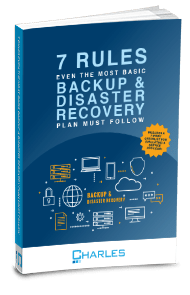.png)
The impact of Hurricane Ian has devastated countless local organizations across the Southeastern United States. While we hope most of these businesses have sufficient backup and disaster recovery plans in place, we know that the destruction left by the storm serves as a lesson in preparedness for all organizations who have yet to consider backup and disaster recovery for their businesses.
Edward Segal, a Senior Contributor to Forbes, commented on the impact of Hurricane Ian and the long road that many businesses have ahead of them.
"Hurricanes can inflict devastating blows on companies and organizations. It’s bad enough when violent storms cause water and wind damage. But after storms pass, business executives must often contend with a second crisis: recovery." Edward Segal, Forbes, Many Businesses Face Another Crisis As They Seek To Recover From Hurricane Ian
In the best-case scenario, companies will have all data backed up with a cloud solution, giving them the ability to restore everything that may be physically destroyed on-site. As Charles IT Systems Administrator, Matt Kurz, explains, "An external hard drive doesn't help if your entire office floated away". Unfortunately, in situations like these, businesses that don't have a backup & disaster recovery plan in place will face challenges in the recovery process.
Without a plan in place, it will be more time-intensive to appoint a team lead responsible for business recovery and the retrieval of lost data (assuming an offsite backup solution was implemented before the data loss). At the risk of sounding like a broken record, it's absolutely essential for every business, no matter the size or location, to have a backup & disaster recovery plan in place. After all, disaster could strike at any time, and Hurricane Ian reminds us of that.
As Baruch Labunski, CEO of Rank Secure was quoted saying, "Business leaders can take note that anything can happen and need to have a backup system for operating outside of their corporate headquarters, wherever that is located."
The first step to ensure you're prepared for any type of disaster, natural or otherwise, is to work with your IT and cybersecurity team to establish a set, detailed plan. This is especially important if you're located in an area where disasters are more common (hurricanes in Florida, earthquakes along fault lines, you get the gist). Typically, the first step is to implement offsite backups, whether this is virtual cloud storage or a physical data center in a geographically different location.
Charles IT Systems Administrator, Matt Kurz, noted:
"It's important to note that services such as OneDrive and DropBox, etc. are not sufficient backups. A proper backup needs to be compartmentalized from your environment; file syncing services can [still] be fully exposed to malware."
The backup & disaster recovery process can be daunting for any business that isn't well versed in IT or cybersecurity. The process steps are as follows:
- Assess Business Impact - develop a realistic business continuity plan based on how your business would be impacted by a loss of service.
- Assess Maximum Downtime - how much downtime your business can handle before it adversely affects your operations.
- Assess Risk - prioritize your resources based on the potential risks to your business, covering natural and man-made disasters.
Ann Bednarz and Tim Greene from Network World quoted Forrester Principal Analyst, Naveen Chhabra, who explains:
“Leaders ask for ROI justifications before allocating budgets for DR [Disaster & Recovery] programs. While ROI is reasonable for many initiatives, unfortunately [it’s] not for DR. Instead, what they need to look for is the true cost of downtime.” - Naveen Chhabra, Forrester
Following the aforementioned steps will help your business identify any gaps or missing elements, and address them before disaster strikes. One final note; ensuring you've fully tested your plan is essential. A complete, well-tested plan should result in the following practices:
- Data is backed up every 60 minutes, every day.
- Compliance with all laws and regulations achieved.
- Your business is back up and running – fast [in the event of a disaster].
- Recovery of your vital emails and contacts [is fully functioning].
- All data is kept safe when disaster strikes.
An experienced managed services provider, like Charles IT, can help to ensure your business has no worries if a disaster were to strike.
We know how important data is to any business, along with how important a quick turnaround after a disaster is. We got this. Call us today to schedule a time to talk to one of our experts about how we can help your unique business!
Not quite ready to call? No problem - check out our Backup & Disaster Recovery eBook below!





